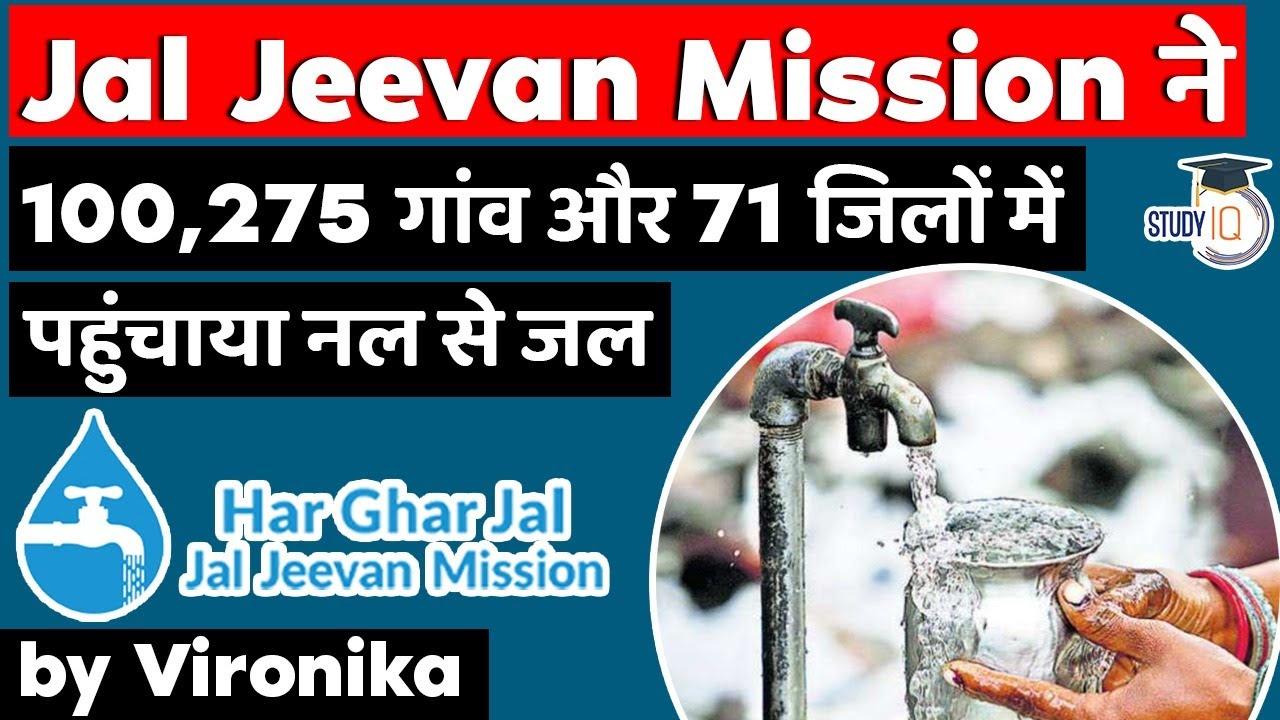Table of Contents

- 71 districts, 824 blocks, 50,309 gram panchayats and 1,00,275 villages have tap connections in each house after almost two years of launching ‘har ghar jal’ mission

States which have achieved 100 percent tap water supply in rural areas:
- Goa
- Telangana
- Andaman and Nicobar Islands
- Puducherry
Amount allocated
- Rs 3.60 lakh crore have been allocated by the government to provide tap water supply to every rural household.
- In 2020-21 an amount of Rs 11,000 crore was allocated for the States/UTs.
- For 2021-22, the current financial year a four-fold increase in fund allocation has been approved by the union minister Jal Shakti, so that there is no dearth of fund requirement to achieve the goal.
- In just three months, Rs 8,891 crore has been drawn by the States/UTs based on the fund utilization and requirement proposed under their annual action plans (AAPs).
Prioritized areas for providing tap water supply
- Water-scare areas
- Qualify-affected villages
- Aspirational districts
- SC/ST majority villages
- Saansad Adarssh Gram Yojna villages
- During the last 23 months, tap water supply has increased four-fold from 7 per cent to 33 per cent in 117 aspirational districts. Similarly, more than 97 lakh households have been provided with tap water supply in 61 districts affected by Japanese Encephalitis- Acute Encephalitis Syndrome (JE-IES). 696 SAGY villages and 29,063 SC/ST majority villages have become ‘Har Ghar Jal.’
- Water quality monitoring and surveillance activities are being given top priority, for which Anganwadi workers, ASHA workers, members of self-help groups, PRI members, school teachers etc; are being trained so that they can test water samples for contamination by using Field Test Kits (FTKs). There are 2,015 laboratories across the country.
Jal Jeevan Mission
- Jal Jeevan Mission (JJM) envisages supply of 55 litres of water per person per day to every rural household through functional household tap connections (FHTC) by 2024.
Objective
- The mission is based on a Community Approach to waterand includes extensive information, education and communication as a key component of the mission.
Funding pattern:
- The fund sharing pattern between the centre and states is 90:10 for himalayan and north-eastern states, 50:50 for other states, and 100% for union territories.
Jal Shakti Ministry
- The government has created a new ministry called ‘jal shakti’after merging ministries of water resources, river development & ganga rejuvenation along with drinking water and sanitation.
Institutional Arrangement
- National Jal Jeevan mission (NJJM) at the central level
- State water and sanitation mission (SWSM) at the state level
- District water and sanitation mission (DWSM) at the district level
- Village water sanitation committee (VWSC) at village level
Drinking water crisis in India
- According to the NITI Aayog’s Composite Water Management Index (CWMI) 2018, 21 Indian cities could face Day Zero in the coming years. Day Zero refers to the day when a place is likely to have no drinking water of its own. Bengaluru, Chennai, Delhi and Hyderabad are among the most susceptible.
- The report also said that 75% of Indian households do not have drinking water on premise and about 84 per cent rural households do not have piped water access.
- Water is not properly distributed where it is supplied through pipes. Mega cities like Delhi and Mumbai get more than the standard municipal water norm of 150 litres per capita per day (LPCD) while others get 40-50 LPCD.
- The World Health Organization prescribes 25 litres of water for one person per day to meet all basic hygiene and food needs. Extra available water, according to WHO estimates, is used for non-potable purposes like mopping and cleaning.
Way Forward
- It is an urgent requirement of water conservation in the country because of the decreasing amount of groundwater level.
- Therefore, the Jal Jeevan mission will focus on integrated demand and supply management of water at the local level.
Question:
Consider the following statements:
- “Catch the Rain” campaign was launched on March 22,2021 on the occasion of World Water Day for conserving water.
- This campaign will be implemented across the country, in both rural and urban areas from March 22 to November 30, 2021.
Which of the above statement is/are correct?
- Only 1
- Only 2
- Both 1 and 2
- None of the above
Latest Burning Issues | Free PDF

























 WhatsApp
WhatsApp